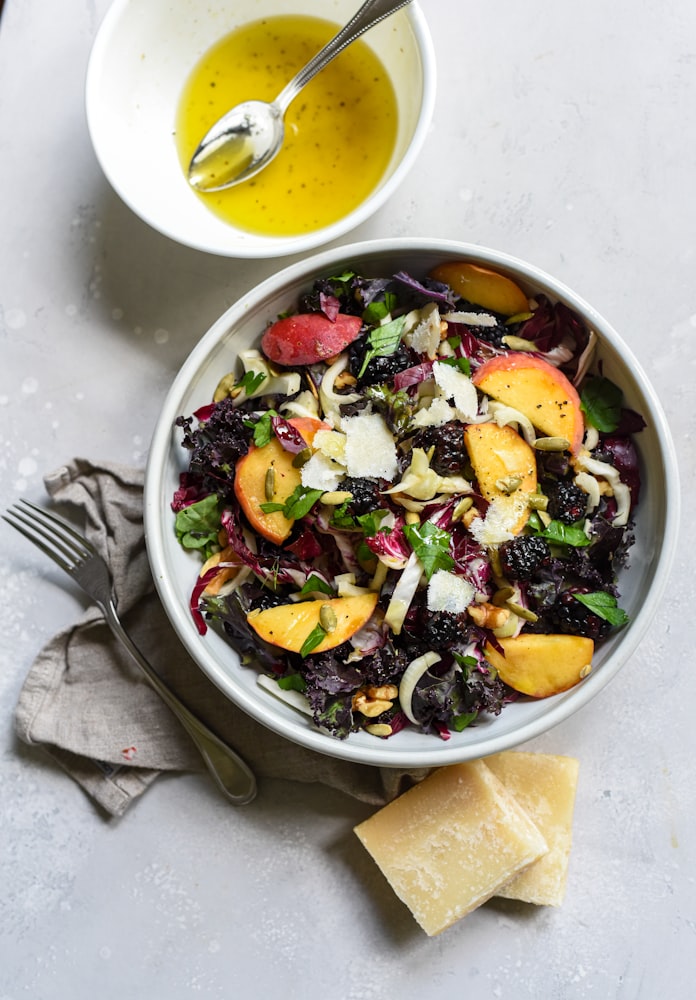In a Nutshell:
- Shelf Life: Store-bought salad dressings can last for over a year unopened, and 6+ months after opening. Homemade salad dressings typically only keep for about one week in the refrigerator.
- Spoilage Signs: Check for changes in color, smell, and texture. If your dressing starts to separate, develop a funky smell, or show signs of mold, it’s time to toss it out.
- Storage Methods: Refrigeration is key for open bottles and homemade dressings. Keep your dressings in an airtight container, in the coldest part of your fridge, to extend their freshness.
Ever found yourself staring suspiciously at a bottle of leftover dressing, questioning its life expectancy or mulling over the potential dangers of food poisoning?
Whether you’re a lover of store-bought salad dressings or you’ve taken a more culinary approach and started making your own, we’ve all been there.
This article will be your go-to guide on the shelf life, spoilage signs, and best storage methods for salad dressings. So, keep reading and say goodbye to the guesswork!

Table of Contents
- How Long Does Salad Dressing Last?
- How to Tell if Salad Dressing is Bad?
- When It’s Weird, But It’s Fine
- Does Salad Dressing Need to Be Refrigerated?
- How to Store Salad Dressing
How Long Does Salad Dressing Last?
Unopened salad dressing typically has a shelf life of up to a year, and it retains quality for at least a couple of months beyond the best-by date. Once opened, most salad dressings keep quality for 6 to 9 months, or until the printed date, if refrigerated.
That’s the high-level overview.
Next, let’s dive into the details.
Unopened
Salad dressing, whether a tangy Italian or a creamy ranch dressing, has a shelf life of about a year, and it keeps good quality for at least a couple of months beyond the best-by date.
So don’t sweat if you cross the best-by date printed on the label – it’s not an expiration date but rather a peak quality guideline. If the salad dressing is unsealed and the bottle intact, that expired salad dressing should be safe to eat.
(That doesn’t mean the quality will be great, but we’ll get to that in a bit.)

After Opening
Once you break that seal, your salad dressing should typically retain quality for 6 to 9 months or until the printed date. Most store-bought bottled salad dressings last quite a while after opening thanks to preservatives added in the production process.
(Unlike hot sauce or soy sauce, which don’t need extra help to stay safe for such a long period.)
Of course, some dressings out there have a much shorter shelf life after opening. And that’s why you should closely examine the label, looking for instructions related to handling the leftovers.
In most cases, the bottle will say “Refrigerate after opening,” meaning it’ll retain quality for a while. But if it says something like “Refrigerate for up to 5 days,” it’s pretty clear you need to use the leftovers quickly.

Expired
What if you’ve stumbled upon a bottle of salad dressing well past its use-by date? Should you use it or lose it?
As mentioned, bottled salad dressings typically keep well beyond the printed date. And that means you can eat expired salad dressing as long as it doesn’t show any spoilage signs and the quality is good enough.
In other words, your senses are your best guide here.
If it smells, looks, or tastes off, toss it. No Caesar salad is worth the risk of food poisoning. But if everything seems okay, and the dressing isn’t like two years past its date or opened for more than 12 months, it’s likely okay to use.
(We’ll explore signs of spoilage later in the article.)
Homemade
Homemade salad dressings keep for about a week in the fridge. And that’s true whether it’s an oil-based salad dressing (like a balsamic vinaigrette) or a dairy-based one.
If you want to keep it extra safe, limit that storage time to 3 to 4 days, the standard storage period for perishable leftovers.

Dry Mixes
Dry salad dressing mixes are the marathon runners of the dressing world.
Much like dry spices, a dry mix can last up to two years in your pantry if kept in a cool, dry place. And it’ll retain decent quality for months, if not years, beyond the printed date.
Once mixed with oil or vinegar, however, the shelf life reduces to that of a typical homemade dressing. And again, it doesn’t matter if we’re talking about oil-based dressings or dairy-based ones.
Now that you’re all brushed up on salad dressing shelf life, it’s time to put on your detective hat. Next up, we’re diving into how to spot the telltale signs of spoilage.

How to Tell if Salad Dressing is Bad?
As a general rule of thumb, if your salad dressing has a rancid smell, changes color, or shows signs of bacterial growth such as mold, it’s time to bid it farewell.
Now, let’s break down these signs and get into the details.
Off Smell
The first telltale sign of a spoiled dressing is a rancid smell. Much like when your sriracha has turned rogue, or the fish sauce has sailed to stinky shores, your nose is your greatest ally in this investigation.
If your dressing has developed an off smell, it’s a clear signal to show it the bin, not your salad.
Mold
The most definitive sign that your dressing is ready for the trash can is mold. So if you see any greenish-blue or white fuzz, it’s time to say goodbye.
This holds true for all your condiments, from tartar sauce to mustard. If it’s fuzzy and it’s not a peach, it’s probably no good!

Color Changes
The next sign to look for is a change in color.
Now, it’s not as clear cut as mold or rancid smell. Slight hue changes are expected for salad dressings, especially those stored for quite a long time after opening.
(It works the same for ketchup.)
But if the color has changed completely, be cautious. Start by shaking the dressing, then taste a tiny bit. If the taste is okay, chances are the dressing is too. But if it tastes off, its place is in the trash.
Quality
The last thing to assess is the overall taste and quality.
If the dressing has been stored properly and doesn’t show any spoilage signs mentioned above, it’s time for the good old taste test. Eat a bit and decide whether the quality is good enough for your liking.
If it’s not, it’s time to open a fresh bottle.
Now that we’ve covered the clear red flags, let’s move on to the subtler signs and understand what’s okay and what’s not.

When It’s Weird, But It’s Fine
Here are some signs that might worry you but are completely normal and nothing to be concerned about.
Separation
Ever picked up your vinaigrette or oil-based dressing and noticed it has separated? Don’t fret.
Separation is natural in such dressings, much like it is in natural peanut butter or almond butter. A quick shake should reunite the components, and your dressing will be ready to grace your greens once again.
Texture Change
Sometimes, your dressing might thicken up or become clumpy, especially if it’s been sitting in the fridge.
This doesn’t necessarily mean it’s spoiled. It’s just the chilly temps causing the fats to solidify, much like what happens to some oils. A quick stir or a few minutes at room temperature (after pouring) should bring it back to its pourable self.
Remember, when in doubt, it’s better to be safe than sorry. So if you’re unsure, it might be time to whip up a fresh batch of dressing or grab a new bottle from the store.
Knowing that, let’s talk about storage practices.
Does Salad Dressing Need to Be Refrigerated?
In a nutshell, unopened store-bought salad dressing doesn’t usually need to be refrigerated, much like your favorite bottle of barbecue sauce or teriyaki sauce. But once opened, it’s best to keep it chilled.
Unopened salad dressings are shelf-stable condiments in most cases. So unless you buy yours in the refrigerated section, room temperature is good enough.
Once opened, things change.
To maintain the best quality and prevent bacterial growth, opened salad dressings should be kept in the refrigerator. This is similar to the storage rule you’d follow for mayonnaise or horseradish sauce.
Homemade Rules
For homemade dressings, the fridge is always your best bet, from the moment they’re made. Think of them like any other homemade sauce or dip – without the preservatives found in their store-bought counterparts, they’re a bit more high-maintenance.
Alright, we’ve got the refrigeration part down. Now, let’s look at the broader picture of salad dressing storage.
How to Store Salad Dressing
Storing salad dressing properly is just as important as proper food storage for any other product. Here are a few storage tips to ensure your dressings are always ready to dress up your salads.
Sealing the Deal
Whether store-bought or homemade, keeping your salad dressing sealed tightly is crucial. Half-open bottles are a big no-no.
Just like you wouldn’t leave your anchovy paste or Dijon mustard lids ajar, make sure your dressing is locked up tight to keep out unwanted bacteria and odors.
Keep it Cool
Your refrigerator is your salad dressing’s best friend. The back of the fridge, far from the door, is the coldest and most stable area.
Away from the Light
Just like your favorite superheroes (or vampires?), salad dressings do their best work in the dark. Store your dressings away from direct light and heat sources to maintain their quality.
By following these storage guidelines, you’ll ensure your salad dressings retain their delicious flavors and textures, ready to bring your salads to life at a moment’s notice.